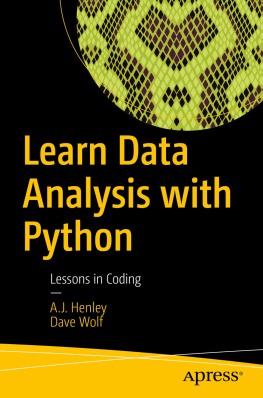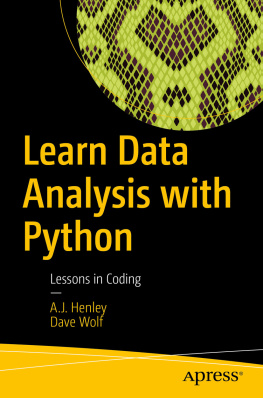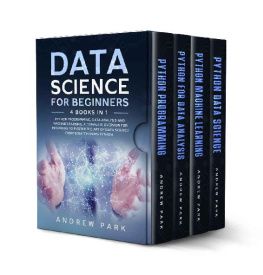Scratch Eric - Python Algorithms: ( A Complete Guide to Learn Python for Data Analysis, Machine Learning, and Coding from Scratch)
Here you can read online Scratch Eric - Python Algorithms: ( A Complete Guide to Learn Python for Data Analysis, Machine Learning, and Coding from Scratch) full text of the book (entire story) in english for free. Download pdf and epub, get meaning, cover and reviews about this ebook. year: 2020, genre: Home and family. Description of the work, (preface) as well as reviews are available. Best literature library LitArk.com created for fans of good reading and offers a wide selection of genres:
Romance novel
Science fiction
Adventure
Detective
Science
History
Home and family
Prose
Art
Politics
Computer
Non-fiction
Religion
Business
Children
Humor
Choose a favorite category and find really read worthwhile books. Enjoy immersion in the world of imagination, feel the emotions of the characters or learn something new for yourself, make an fascinating discovery.

- Book:Python Algorithms: ( A Complete Guide to Learn Python for Data Analysis, Machine Learning, and Coding from Scratch)
- Author:
- Genre:
- Year:2020
- Rating:4 / 5
- Favourites:Add to favourites
- Your mark:
- 80
- 1
- 2
- 3
- 4
- 5
Python Algorithms: ( A Complete Guide to Learn Python for Data Analysis, Machine Learning, and Coding from Scratch): summary, description and annotation
We offer to read an annotation, description, summary or preface (depends on what the author of the book "Python Algorithms: ( A Complete Guide to Learn Python for Data Analysis, Machine Learning, and Coding from Scratch)" wrote himself). If you haven't found the necessary information about the book — write in the comments, we will try to find it.
Scratch Eric: author's other books
Who wrote Python Algorithms: ( A Complete Guide to Learn Python for Data Analysis, Machine Learning, and Coding from Scratch)? Find out the surname, the name of the author of the book and a list of all author's works by series.
Python Algorithms: ( A Complete Guide to Learn Python for Data Analysis, Machine Learning, and Coding from Scratch) — read online for free the complete book (whole text) full work
Below is the text of the book, divided by pages. System saving the place of the last page read, allows you to conveniently read the book "Python Algorithms: ( A Complete Guide to Learn Python for Data Analysis, Machine Learning, and Coding from Scratch)" online for free, without having to search again every time where you left off. Put a bookmark, and you can go to the page where you finished reading at any time.
Font size:
Interval:
Bookmark:
- Grab a tube of toothpaste in one hand and open the cap using your other hand.
- With your other hand, grab hold of a toothbrush in an upright position with the bristles facing you.
- Bring the tube of toothpaste that you were holding in your other hand closer to the bristles of the toothbrush.
- Squeeze enough toothpaste onto the brush placing it on the bristles of the brush.
- Put the tube of toothpaste down on the counter so you can begin brushing.
- Open your mouth and smile.
- Press the bristles of your brush against your front teeththis will apply toothpaste on your teeth.
- Brush your front teeth with an up and down motion.
- Do this for 10 seconds.
- Press your brush against the molars on your jaw near your left cheek. Brush those teeth with an in-and-out motion (aka a forward and back motion).
- Brush for 10 seconds.
- Press your brush against the molars on your jaw near the right cheek this time. Brush with an in and out motion.
- Brush for 10 seconds.
- Take the brush out of your mouth and rinse it with water from the tap.
- Grab a glass of water and gargle. Spit the water out into the sink.
- You are done brushing.
Font size:
Interval:
Bookmark:
Similar books «Python Algorithms: ( A Complete Guide to Learn Python for Data Analysis, Machine Learning, and Coding from Scratch)»
Look at similar books to Python Algorithms: ( A Complete Guide to Learn Python for Data Analysis, Machine Learning, and Coding from Scratch). We have selected literature similar in name and meaning in the hope of providing readers with more options to find new, interesting, not yet read works.
Discussion, reviews of the book Python Algorithms: ( A Complete Guide to Learn Python for Data Analysis, Machine Learning, and Coding from Scratch) and just readers' own opinions. Leave your comments, write what you think about the work, its meaning or the main characters. Specify what exactly you liked and what you didn't like, and why you think so.





